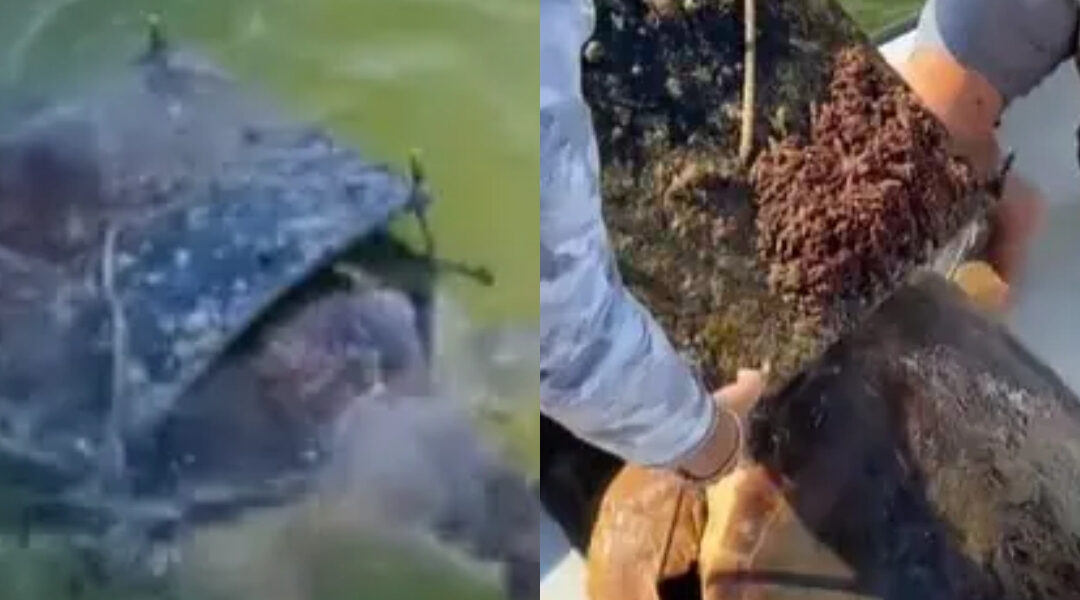Sometimes, nature seems to whisper in ways we can’t explain — a quiet instinct, a guiding pull toward hope. That’s exactly what appeared to happen one calm morning in St. Joe Bay, Florida, when a distressed sea turtle swam straight toward the very people who could save its life.

The team aboard the small research vessel belonged to the Northern Gulf Turtle and Coastal Research Group, scientists who dedicate their days to studying and protecting marine life along Florida’s coast.
They had been out since sunrise, scanning the waters for sea turtles to tag and monitor as part of their ongoing conservation work.
Then they saw it.
At first, it looked like a floating bundle of seaweed or driftwood. But as they drew closer, they realized it was moving — struggling. Beneath the surface, a large loggerhead turtle was caught in a tangled mass of ropes, plastic, and buoys.

It was trapped in what’s known as a Fish Aggregating Device (FAD) — a floating structure meant to attract fish, but one that often drifts away and becomes deadly marine debris.
FADs are illegal in protected waters like St. Joe Bay, and this was a perfect example of why. The ropes had coiled around the turtle’s fins, cutting into its skin. Exhausted from fighting to stay afloat, the animal looked moments from giving up.
Then, something extraordinary happened.

Instead of panicking, the turtle began to swim directly toward the researchers’ boat. Slowly, laboriously, it paddled closer, as if drawn by some deep, instinctive understanding that these humans were different — that they could help.
“It swam right up to us,” one of the rescuers later recalled. “Almost like it knew.”
Without hesitation, the team went to work. One scientist reached into the water, gently steadying the animal while the others pulled the heavy FAD closer to the boat. It took all their strength to lift the massive creature — nearly 300 pounds of shell, muscle, and spirit — safely onto the deck.

The turtle’s breaths came slow and uneven. Tangled cords cut across its front flippers, and barnacles clung to its shell.
Every movement was labored. Yet, even in its distress, it stayed calm — eyes blinking, flippers twitching slightly, as the team spoke to it in soothing voices.
“Hang in there, big guy,” one murmured. “We’ve got you.”
For several minutes, the sound of the waves mixed with the snip of knives and cutters as the team worked quickly to free it. Piece by piece, the ropes came away. With each cut, the turtle’s breathing seemed to ease — until finally, the last strand dropped to the deck.
They took a moment to examine their patient, checking for wounds and injuries.
Despite the ordeal, the loggerhead was remarkably strong — a survivor in every sense. After a few minutes of observation, it lifted its head high and took a deep, full breath of salty air.
That was their signal.
The researchers eased it back into the turquoise water. For a moment, the turtle lingered beside the boat, turning its head toward them. The ocean rippled around it, sunlight glinting off its shell like gold. Then, with one powerful kick, it glided away — free once more.
There was silence on deck for a few seconds, the kind of silence that only comes after witnessing something sacred. Then someone exhaled, smiling through the stillness. “That,” they said softly, “is why we’re here.”
Later, the Northern Gulf Turtle and Coastal Research Group shared the rescue video on Instagram — not for attention, but as an urgent reminder.
“FADs are illegal in marine protected areas such as St. Joe Bay because they often become debris and can cause entanglement of sea life such as sea turtles,” the caption read.
The video spread quickly, touching hearts around the world. People commented on the turtle’s incredible timing — how it had seemed to seek out its rescuers — and on the compassion of the scientists who answered its silent plea.
It was, at its core, a story of trust: a wild creature choosing to approach the hands of humans, and humans choosing to use that trust for good.
The researchers ended their post with a gentle warning to fishermen and boaters — to follow the rules, to protect the fragile ecosystems they depend on, and to remember that even one piece of carelessness can cost a life.
For that one loggerhead turtle, the ocean is safe again. And somewhere in the blue depths of St. Joe Bay, a survivor now swims freely — a living reminder that sometimes, when all hope seems lost, help is closer than we think.




